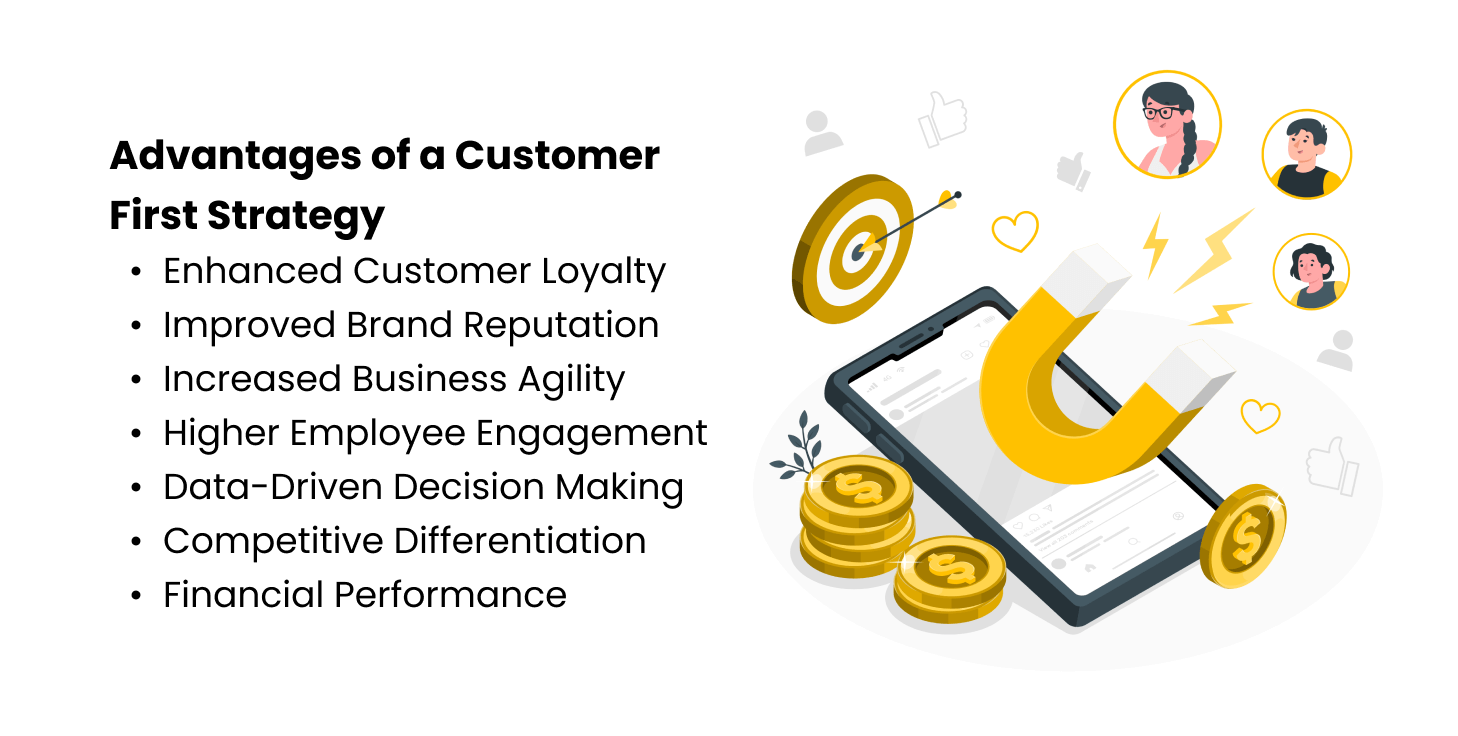Gone are the days when customer first was merely a catchy slogan. Today, it's the heartbeat of successful companies, a game-changing business strategy that can catapult a business from mediocrity to market leadership.
But what does putting the customer first really mean?
In this article, we will reveal all the secrets and more.
What Does Customer First Approach Mean?
A customer first strategy revolves around the interests and demands of customers or target audiences as its fundamental concern. This spirit is far more than ‘just customer service.’ It is the all-encompassing philosophy and customer-centered culture that permeates any and every element of a business – product development through a marketing campaign, sales, or after-sales support.
There are several definitions of customer first. Primarily, the meaning of customer first is geared towards the relentless pursuit of the ultimate customer satisfaction. It treats feedback from the target customers as a necessary foundation for continuous improvement. It is a business around customer needs.
A customer first perspective looks at all business decisions as they relate to the end user. It’s about understanding that every contact, however small it may appear to be, is part of the larger customer journey. Those companies that win in customer first recognize the value of creating positive, memorable, and not poor customer experiences that facilitate loyalty and advocacy.
A client-first approach also includes a thorough insight into customer expectations, needs, and desires. Knowing this insight allows businesses not just to satisfy but also to predict customers’ needs, which results in the innovation of solutions and services fit for their market.
Advantages of a Customer First Strategy
Embracing a customer first strategy offers numerous benefits that can take a business to new heights.
Here are some key advantages:
- Enhanced Customer Loyalty
By putting customers first and embracing customer empathy, successful companies foster stronger emotional connections with their customers. This loyalty translates into repeat business, fewer unhappy customers, and a higher customer lifetime.
- Improved Brand Reputation
Happy customers tend to spread the word. Having an approach where you put the customer first in all marketing communications can help grow a brand ambassador who has the capacity to drive positive word of mouth and is ultimately very powerful for boosting brand reputation among the target audience.

- Increased Business Agility
Focusing on customers simply means keeping abreast of their changing needs. This sort of awareness allows businesses to adapt rapidly, which keeps them ahead of market trends and competitors' moves.
- Higher Employee Engagement
A customer first mentality should not be only about customers since it also helps employees. When the staff understands and is committed to the mission of putting customers first, their engagement and productivity levels are usually high as well as they transform into happy employees.
- Data-Driven Decision Making
First customer strategy builds on the feedback and data that come from consumers in order to make more grounded, effective business decisions. This data-centric strategy can unveil the valuable insights that spark innovation and growth.
- Competitive Differentiation
In the markets where there are many products and services that are competing and occupying an almost similar place, a great customer first strategy could be one of the differences between you and your competitors.
- Financial Performance
Many researchers have found a relationship between customer satisfaction and financial performance. The highest-performing companies, in terms of putting the customer first, can usually achieve enhanced profitability and revenue growth.
Best Ways to Put the Customer First
Implementing a customer first strategy involves various practices and principles.
Here are some effective ways to ensure your business is putting customer first:
Understanding Customer Needs
It is based on in-depth knowledge of the needs and desires of your target audience. This entails collecting and analyzing customer opinions, observing customer behavior, and keeping the market information up-to-date. If you know what your customers desire and expect, you can design products, services, and experiences based on their preferences.
Implementing a Customer First Mindset
Instilling a customer-centric mindset within the team is vital. This involves teaching employees how to think and behave so that they can satisfy customers’ needs. The focus is on cultural values that would ensure your organization has an understanding of the customer’s perspective in all decisions, whether large or small.
Building Lasting Customer Relationships
Customer loyalty and advocacy are achieved only through strong relationships. Putting customers first requires establishing effective, long-term customer relationships. This is measured by frequent and significant communication, customized experiences, and demonstrating sincere gratitude for their patronage.
Analyzing Customer Satisfaction Metrics
Measuring and analyzing customer satisfaction is key to a successful customer-first strategy. Use such customer experience metrics as NPS, CSAT, and CES to measure customer satisfaction levels and pinpoint areas that can be improved.
Training Your Teams How to Put Customers First
To establish the customer first mentality, regular training and development sessions must be conducted. Employees need to be trained on the skills and principles needed in customer service delivery, as well as the importance of putting customers first during every interaction to transform into proactive customer service teams.
Keeping Abreast of Trends and Innovations
Putting the customer first can also be achieved by being ahead of industry trends and technological innovations. Taking an active approach and adjusting to the changing market environment allows you to meet customer requirements better and offer more valuable solutions.

Listening to Your Customers
Lastly, active listening to your customers is essential. Encourage the customers to give you feedback, take it seriously, and act upon it. Showing that you appreciate their input is one strong way of customer first.
Сhallenges During Implementation Customer First Approach
Implementing such a strategy is not without its challenges. Understanding and overcoming these hurdles is essential for businesses committed to putting customers first.
Here are some common challenges:
- Organizational Resistance
Changing the existing company culture to adopt an approach when the customer comes first can meet resistance. Employees might have their ways or be skeptical of new approaches. Overcoming this requires strong leadership and clear communication of the benefits of why you need to put customers first.
- Integrating Customer Feedback
Gathering feedback is one thing, but using it in business practices is completely another. Companies have notorious difficulty analyzing and addressing customer insights to make improvements on their products, services, and experiences.
- Training and Development
Ensuring all employees within the customer support team understand and can implement a customer first approach demands continuous training and development. This can be resource-intensive and challenging to maintain consistently across large organizations.
- Balancing Customer Needs with Business Goals
Sometimes, what customers want may not align perfectly with the company's immediate business goals or capabilities. Finding a balance where customer satisfaction and business objectives meet is a yet another common challenge.

- Maintaining Consistency Across All Channels
Consistency on customer first experience across various touch points — online, in-store, customer experience platform, or customer service — for businesses with a wide range of products and services is not an easy feat.
- Measuring Success
Defining and measuring the success of a customer first strategy can be tricky. Businesses need to identify the right metrics that accurately reflect customer satisfaction and business impact.
Success Stories of Companies Embracing a Customer First Strategy
Some companies across various industries have successfully implemented a customer first strategy.
Let’s have a look at a few notable examples:
Amazon
Famous for its pathological customer focus, Amazon has raised the bar on putting customers first. From its user-friendly website to the hassle-free return process, everything Amazon does is geared towards satisfying customers.
They introduce new features such as one-click shopping, personalized recommendations, and the prime membership that provides free, fast shipping and streaming services. These programs have played a major role in their customer satisfaction scores and loyalty, giving them a competitive advantage.
In terms of numbers, Amazon has frequently performed well on the American Customer Satisfaction Index (ACSI), which shows that its customer first approach really works.
Zappos
Zappos takes the customer first approach to higher levels. Their 365-day return policy and their round-the-clock customer service have redefined the retail industry.
Zappos' customer-first business model implies they do not just do transactions but relationships. They teach their proactive customer service teams how to establish personal relationships and positive customer experiences with the clients, often resulting in long yet very interesting talks. The company’s unique approach has led to high customer retention and word-of-mouth referrals, which are crucial factors for the company’s growth.
Apple
Apple's customer-first marketing strategy permeates into product manufacturing and delivery within the company. They work towards developing intuitive, visually appealing products that serve and surpass the needs of their users. This strategy has cultivated a loyal customer base and brand ambassadors globally.
Apple stores, characterized by unique designs and excellent customer experience platforms, offer personal assistance through the Genius Bar, improving customer satisfaction. Economically, Apple’s customer satisfaction efforts have resulted in a large market share in different segments and a high CLV.
Customer First: Conclusions
A customer first strategy is more than a mere business tactic on consumer trends; it is the overall direction of a company and sometimes its ultimate success.
When businesses adopt the principle of putting customers first, then not only do they improve customer satisfaction and loyalty but also create a platform for growth through quality customer experiences. This strategy should be applied in the long term, with great knowledge of customer needs and the ability to adapt to dynamic changes.
FAQs
What does customer first mean?
Customer first is a business philosophy in which the customers’ needs and satisfaction are considered in everything an organization does. It consists of formulating decisions and shaping quality customer experiences based on customer interests.
Why is it important to put the customer first?
It is important for several reasons. It has the capacity to generate trust and loyalty, differentiate a brand from its rivals, and result in repeat business. Happy customers tend to become brand ambassadors of the company, advertising it through word-of-mouth, which is a boon for growth and business success.
How does a customer first strategy benefit businesses?
The benefits of adopting a customer first strategy include increased customer loyalty, improved brand image, enhanced repeat deals, and lower cart abandonment rates. This ultimately results in increased customer satisfaction, which frequently translates into better financial performance since satisfied customers tend to buy again and refer to others.
What are the customer-first golden rules?
The golden rules for a customer-centric approach are to engage in active listening, understand the needs of the customers as well as consumer behavior, offer superior products and services, customize quality customer experiences based on individual needs as well as be proactive and responsive during communication with consumers or when addressing customer concerns. Such principles are helpful in creating a solid customer base with loyalty towards the seller and result in the overall success of a business and competitive advantage among rivals.







